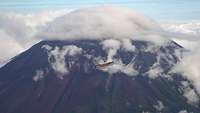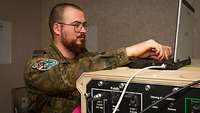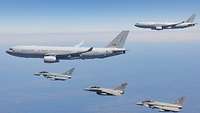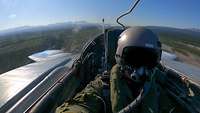For the first time, the German Air Force is training in Japan
For the first time, the German Air Force is training in Japan
- Date:
- Place:
- Japan
- Reading time:
- 3 MIN
It was a special encounter against the backdrop of the Fujiyama. In September 2022, three German and three Japanese combat aircraft met at Japan’s famous landmark for formation flights during the Rapid Pacific exercise. Now, during a tangible continuation to this symbolic gesture, it is once again time to say “Konnichawa” (Hello).
The Nippon Skies exercise from 22 to 25 July will be the first time the German Air Force and the Japan Air Self-Defense Force (JASDF) train together in Japanese airspace. The stay is part of the Pacific Skies 24 exercise series. By participating in this exercise, the German Air Force once again proves its rapid global deployability without neglecting the protection of NATONorth Atlantic Treaty Organization airspace in Europe.
What is the purpose of Nippon Skies?
The exercise strengthens the German-Japanese partnership and provides an opportunity for an exchange of technical and tactical know-how. For example, Japan is already using the highly advanced F-35 combat aircraft that will replace the Tornado in Germany in a few years. The exercise strengthens mutual trust and the established military partnership leads to practiced interoperability and respect.
When does the German Air Force deploy to Japan?
After completion of the Arctic Defender exercise in Alaska, the crews will deploy across the Bering Sea to Japan (just under 5,000 kilometres away) on 19/20 July. About seven hours are scheduled for the air transfer.
How many aircraft will the German Air Force deploy to Japan?
The German Air Force will take part in the exercise with three Eurofighters and one A400M transport aircraft. After a stopover in Japan, further Eurofighters of the Bundeswehr as well as combat aircraft of the French and Spanish Air Force will take off directly to Australia where they are scheduled to participate in the multinational Pitch Black exercise, also part of Pacific Skies 24, from 22 July. The Eurofighters that practice in Japan, however, will continue to the RIMPACRim of the Pacific (Rim of the Pacific) exercise in Hawaii on 26 July.
Who is in charge during the Nippon Skies exercise?
The lead element is 73 Tactical Air Wing Steinhoff based in Laage, Mecklenburg. The starting point of the exercise flights is Chitose Air Base near the two-million metropolis of Sapporo in the north of the country.
What exercise elements are planned?
15 takeoffs are planned for the three Eurofighters and 6 for the A400M.
Which aircraft take part?
In Japan, the Eurofighters and the A400M of the German Air Force will practice together with six F-15 combat aircraft of the Japanese partners.
How did the military cooperation develop between the air forces?
The German Air Force first showed its presence in Japan when a Transall of 63 Air Transport Wing was invited to the International Aerospace Exhibition in 1968. In 2022, the German Air Force participated in the multinational Pitch Black 22 exercise in Australia along with Japanese forces. On the return flight, there was a stopover in Tokyo, which marked the first landing of a German combat aircraft on Japanese soil. Now, the air forces will meet again in the course of Nippon Skies and Down Under for Pitch Black 2024.
What is the geopolitical importance of these exercises?
In September 2020, the German Government adopted its policy guidelines on the Indo-Pacific region. Among other things, they state: “With the rise of Asia, the political and economic balance is increasingly shifting towards the Indo-Pacific. The region is becoming the key to shaping the international order in the 21st century.”
The overarching objective of the policy guidelines on the Indo-Pacific region in the field of security policy is the preservation of the rules-based international order. Free access to sea routes and stability in the region are also crucial for Europe’s security and prosperity. In this respect, security in the Euro-Atlantic area and security in the Indo-Pacific region are interconnected.
That is why Germany, as well as its European partner nations France and Spain, intensified their security engagement in this part of the world. With their presence in this region, the European air forces are contributing to the security of international airspace.






